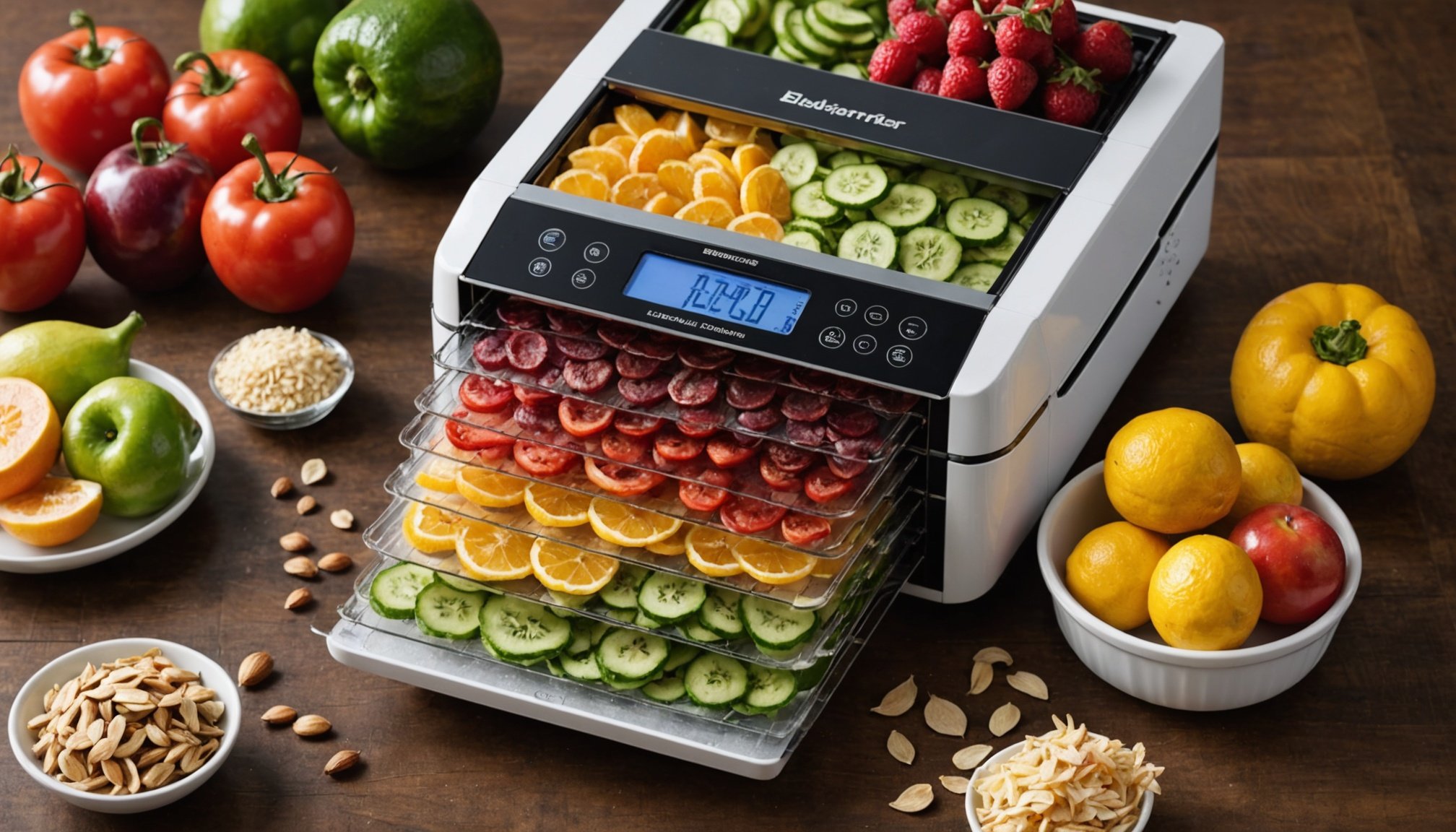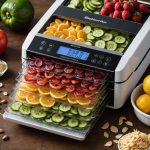Understanding Food Dehydrators and Their Benefits
Food dehydrators are essential tools in the kitchen, designed to remove moisture from food to extend its shelf life and enhance flavours. By circulating warm air over the food items, dehydrators efficiently dry fruits, vegetables, meat, and herbs, preserving their nutrients. This method of nutrient preservation ensures that vitamins and minerals remain largely intact, often making dehydrated foods a healthier alternative to other preserved options.
Benefits of Dehydrating Foods
One of the primary advantages of using food dehydrators is the enhancement of natural flavours. As water is removed, the concentrated taste of the food becomes more pronounced. Additionally, dehydration helps in maintaining a significant portion of nutrients compared to methods like canning or freezing, which might result in nutrient loss. Hence, this technique supports both nutrient preservation and flavor enhancement, appealing to health-conscious individuals.
Have you seen this : Mastering soft-boiled eggs: your ultimate guide to selecting the perfect egg timer
Dehydration Versus Other Preservation Methods
When compared to other preservation strategies, dehydration stands out for its simplicity and ability to keep food content-rich. Unlike freezing, which requires significant energy resources and equipment, dehydrated items are energy-efficient to store and easy to manage. Food dehydrators thus provide an accessible solution for preserving food while maintaining both nutrient content and delicious taste.
Types of Food Dehydrators
Understanding the various types of food dehydrators can help you select the right one for your needs. With diverse designs available, each type offers distinctive airflow patterns, which fundamentally affect dehydration efficiency.
Also read : Enhance your culinary space: discover the advantages of magnetic knife strips for safety and organization
Vertical Airflow Dehydrators
Vertical airflow dehydrators are crafted with a heating element and fan placed at either the top or bottom. This design aids in rapid drying, particularly beneficial for small batches. However, uneven drying may occur since the airflow does not reach all layers uniformly. Users typically rearrange trays mid-process, which could interrupt the operation. Vertical dehydrators are generally compact, making them ideal for kitchens with limited space.
Horizontal Airflow Dehydrators
Horizontal airflow dehydrators boast the fan and heating element on their rear, promoting consistent and uniform drying across trays. Due to this efficient airflow distribution, users do not need to rotate trays. They are a bit bulkier, but their versatility allows them to handle large quantities of food effectively. Hence, they suit those who frequently dehydrate diverse foods.
Solar Dehydrators
Solar dehydrators rely on solar energy, an environmentally friendly choice. They require clear, sunny conditions for optimal performance. Although they can be less predictable compared to electric models, solar dehydrators offer the advantage of being cost-effective and sustainable, making them suitable for outdoor enthusiasts aiming to minimise electricity use.
Key Features to Consider
When selecting a food dehydrator, several features are essential for optimum performance and flavour retention. Temperature control is a critical factor to consider. The ability to precisely adjust the temperature affects how well the dehydrator maintains the natural flavour and nutrients in food. Consistent and even drying is achieved more effectively with adjustable thermostats, as different foods require specific temperatures to dehydrate properly.
Material is another crucial consideration. Dehydrators are commonly made from plastic or stainless steel. Stainless steel is more durable and generally preferred for its longer lifespan and ease of cleaning. However, it may be heavier and more costly. Plastic models, while lighter and more affordable, may not provide the same longevity.
Evaluating the capacity of a dehydrator is important based on its intended use. For individuals or small households, a compact model may suffice. However, those planning to dehydrate large batches or a variety of foods may benefit from a larger capacity option. Multiple trays allow for the simultaneous dehydration of different items, maximizing efficiency. Carefully assessing these features can guide you in selecting a dehydrator that meets your specific needs.
Practical Tips for Dehydrator Use
Understanding dehydrator usage tips can transform the way you prepare and enjoy your meals. First, focus on food preparation by slicing produce evenly. This ensures uniform dehydration and prevents burning or under-drying. Invest in a quality mandoline slicer for precision and speed. Seasoning is optional but can enhance flavours. Experiment with simple salt and pepper, or be adventurous with chili and garlic for a more robust taste profile.
Regular maintenance of your dehydrator prolongs its effectiveness. After each use, clean trays with warm soapy water, and periodically check the fans for dust accumulation to maintain optimal airflow. It’s wise to follow the manufacturer’s instructions for best results.
Regarding storage, dehydrated foods need a cool, dark, and dry environment. Ample humidity protection is crucial. Use airtight containers or vacuum-sealed bags to maintain freshness. A good practice is to label contents with the dehydration and expiration dates for easy monitoring. By applying these best practices for storing, your dehydrated foods can maintain their taste and nutrition for months, allowing you to enjoy them long after their preparation. This method of preservation not only extends shelf life but also reduces waste, contributing positively to a sustainable lifestyle.
Flavor and Nutrient Preservation Techniques
During dehydration, nutrient retention is crucial to maintain both flavor and health benefits of food. Techniques such as low-temperature drying, freeze-drying, and using dehumidifiers help preserve essential nutrients while removing water content. Controlled drying methods prevent nutrient degradation, ensuring that vitamins and minerals remain intact.
For flavor enhancement techniques, incorporating spices, herbs, and marinades can greatly enrich the taste profile of dehydrated foods. Spices like paprika, cumin, or coriander add depth, while herbs such as rosemary and thyme offer aromatic notes. Marinades can provide both flavor and moisture balance, crucial in maintaining palatable texture once dehydrated.
The choice of dehydration methods influences not just the preservation of nutrients, but also the overall flavor and texture of food. Traditional air drying, freeze-drying, and oven drying techniques have unique impacts on food qualities. Freeze-drying, for instance, often best retains the original taste and texture, while oven drying may enhance flavors through mild toasting.
Understanding these methods allows consumers to choose appropriate techniques for desired outcomes, ensuring both nutrient retention and flavor satisfaction. Experimenting with spices and herbs further personalizes dehydration processes, enriching both the culinary experience and the nutritional profile of dried foods.
Recipes for Delicious Dehydrated Foods
Dehydrated foods offer a world of culinary exploration, transforming simple ingredients into flavorful snacks and putting a new twist on healthy alternatives. These recipes provide unique takes on dehydrating fruits, vegetables, and meats.
Start with fruits, such as mangoes and strawberries. Dehydrate them to make crispy, sweet treats. These dehydrated fruit recipes can be a fun alternative to candy, harnessing the natural sugars for a guilt-free indulgence.
Vegetables like kale and zucchini can also be transformed into dehydrated food recipes. Simply season them with your favourite spices before dehydrating. They emerge with a satisfying crunch, perfect for snacking or adding texture to salads and soups.
For meat enthusiasts, consider jerky made from beef or turkey. Marinate the slices in your favorite sauce for a savory option. This is an excellent way to incorporate protein-rich options into your diet, offering both convenience and flavor.
Incorporating dehydrated ingredients into meals can unleash creative ways to reinvent classic recipes. Imagine using dehydrated tomatoes in pasta sauce, or adding crunchy apple chips to salads for a refreshing twist. The possibilities are endless, making dehydrated foods a versatile addition to any diet.
User Testimonials and Success Stories
Hearing from others can significantly influence our purchasing decisions, especially when it comes to kitchen appliances like food dehydrators. Engaging with user experiences can provide valuable insights into the functionality and reliability of different models. Food dehydrator reviews on various platforms share firsthand accounts of their effectiveness, ease of use, and performance.
Various success stories emerge from seminars and feedback sessions held by food dehydration enthusiasts. Participants often highlight how dehydrators have transformed their culinary experiences, sharing tips and techniques they’ve mastered. Such interactions underscore the practical benefits of owning a reliable dehydrator.
Marketplace reviews frequently point out the best dehydrators in terms of performance and customer satisfaction. Users often appreciate features like digital controls and efficient drying systems. Some claim that these appliances have not only extended the shelf life of their food but also enhanced flavours, demonstrating the versatility of dehydrators.
To truly appreciate a food dehydrator’s value, exploring these user experiences and success stories is invaluable. They offer a glimpse into real-world applications, helping potential buyers make informed decisions. Whether it’s for preserving seasonal produce or experimenting with new recipes, the wisdom shared by current users can be enlightening.
Potential Pitfalls and Common Mistakes
Navigating the world of food dehydrators can be straightforward with the right knowledge. However, common mistakes often deter beginners. One frequent error involves overloading trays, which can obstruct airflow and affect drying consistency. It’s crucial to ensure that food slices are evenly spread for optimal results.
Understanding troubleshooting is key to improving outcomes. If your dehydrator leaves food too moist, check if the temperature setting matches the recommended levels. Inadequate temperature can prolong drying time or lead to spoilage. Similarly, uneven dehydration might arise from misaligned trays, a simple yet often overlooked issue.
To achieve long-term success, following best practices is essential. Start with properly pre-treating food; blanching vegetables can help preserve color and nutrients. Regularly cleaning the dehydrator after each use prevents contamination. Additionally, storing dried foods in airtight containers safeguards them from humidity and extends shelf life.
Implementing these insights can elevate your dehydration skills, resulting in high-quality, shelf-stable products. Adopting a methodical approach not only enhances efficiency but also maximizes the flavors and nutrients of your dried foods.











